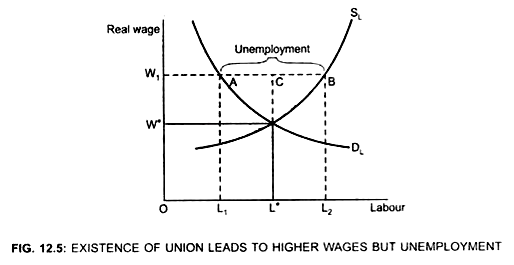I. Minimum – Wage Laws:
Minimum-wage laws fixes a legal minimum limit on the wages that firms have pay to their employees. Wages cannot fall to the equilibrium level.
Minimum wage will not effect the worker if their wages are more than the minimum wage.
But for some workers especially unskilled, minimum wage increases their wage above equilibrium level and they are benefited. But the adverse affect of the law is that it reduces the demand for labour by the firms leading to unemployment.
II. Union and Collective bargaining:
A second cause of wage rigidity is the monopoly power of Unions, due to the presence of unions, the wages are fixed by collective bargaining between union leaders and firm management (and not by the equilibrium between the demand and supply). Often due to collective bargaining power, the trade unions are able to fix wage rate higher than the equilibrium wage rate which adversely affects the labour market for instance:
ADVERTISEMENTS:
(a) Decrease in employment,
(b) A lower rate of job finding and
(c) Increase in wait unemployment.
Firms dislike union because:
ADVERTISEMENTS:
(a) They not only succeed in fixing higher wage but also,
(b) Increase the bargaining power of Labour on many other issues like hours of employment; working conditions etc.
Role of firms to avoid union:
The firms to discourage the formation of union will pay high wage to keep them happy.
Unemployment caused by union is due to the conflict between the two group of workers, insiders and outsiders. Insiders are those workers who are already employed by the firm and outsiders are the unemployed.
In the figure (12.5)
Due to union wages are fixed at W1 > W*
This leads to unemployment = L1 L2
L1L2 = L1L* + L* L2
where L1L* → are the insiders who were employed by the firm but due to high wage they are unemployed.
L*L2 —> are the outsiders who were unemployed and are willing to work at low wage.
The effect of any bargaining on wage and employment depends on the relative influence of each group.
III. Efficiency wages:
According to the Efficiency-wage theories: High wages paid to the workers’ make them more productive, therefore, the firms are reluctant or fail to decrease wages despite of an excess supply of labour. Due to a wage cut although the firms wage bill decreases but at the same time it decreases the workers productivity, which in turn decreases the firms profit. Therefore, the employers are not interested in lowering the wages.
